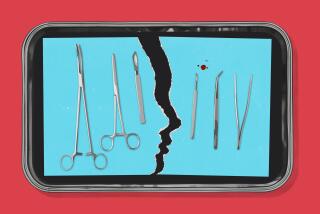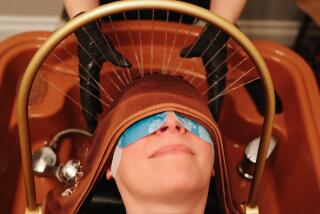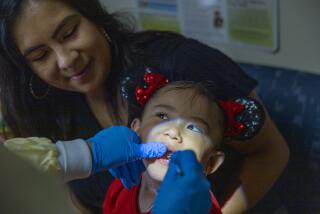Those luxury spa pedicures can have an ugly downside
Sheila Cook settles back in the stuffed leather chair and wiggles her toes in the attached whirlpool basin, bubbling with warm water. As a bank manager who regularly logs a 12-hour day, much of it on her feet, her biweekly spa pedicure is part luxury, part necessity.
“If I don’t get my pedicure, I am cranky,” said Cook, 52, of Shadow Hills.
She’s surrounded by five other throne-like chairs at Unique Hair, Nails & Spa in Eagle Rock, where owners Ray Nguyen and Jennifer Vu, like other salon operators, say the demand for spa pedicures is up. More luxurious than pedicures given in traditional portable foot baths, spa pedicures are performed in whirlpool basins and cost a few dollars more. At Unique, a regular pedicure is $12 and a spa pedicure, $16.
But this extra pampering may come at a price. Since November, two Northern California counties have reported outbreaks of bacterial skin infections associated with pedicures. Public health officials in Orange County have received sporadic reports of similar infections and plan to alert doctors there to watch for pedicure-associated infections.
Health experts trace the problem to spa pedicure whirlpool basins, which are more difficult to clean. The pipe systems in many spa pedicure chair models allow water and debris to stagnate and the filters in the chairs may not be cleaned properly, with contaminants building up.
Kimberly Rutt, 28, of Mar Vista, a magazine ad sales representative, first noticed a discoloration of her left big toenail and left fourth toenail after her usual spa pedicure. Eventually diagnosed with a fungal infection, a doctor prescribed an oral antifungal medicine, which requires regular monitoring of the liver. When that medication failed to clear up the infection after nine months, she had to have the affected toenails removed. “It was painful and I couldn’t wear closed-toe shoes for a while.” At last, she is fungus-free.
While Rutt’s experience may be worse than most, public health officials, dermatologists and podiatrists are cautioning consumers to be extra careful if they choose a spa pedicure -- or to forgo them altogether, stick with the regular pedicure foot baths and use special precautions with them.
In Santa Clara County in Northern California, pedicure-associated infections have begun to level off, said Teresa Chagoya, a spokeswoman for the county Public Health Department. The department has collected 147 reported cases of mycobacterial infections that occurred from January 2004 through March 4.
The type of skin infections seen after pedicures is caused by Mycobacterium fortuitum and other related mycobacteria, according to the California Board of Barbering and Cosmetology, which regulates nail salons.
Of the 147 cases in Santa Clara County, 29 were determined to be mycobacteria and 28 were found not to be; the remaining cases are still pending, Chagoya said.
In Contra Costa County in Northern California, four of 17 cases of pedicure-related bacterial infections reported from November through March 11 have been confirmed, said Francie Wise, a spokeswoman for Contra Costa Public Health.
In Southern California, Orange County public health officials have received sporadic reports of mycobacterial infections associated with nail salons, said Tricia Arcelona, a spokeswoman. In 2004, there were three reports of mycobacterial infections related to nail salons, she said.
Los Angeles County health officials said there had been no reported outbreaks of salon-associated mycobacterial infections in 20 years. But Dr. Laurene Mascola, chief of acute communicable disease control for the county Department of Health Services, said some people might get an infection after a pedicure but didn’t associate the infection with their visit to a nail salon. And they may not mention it to their doctors. A doctor is not required to report a single case of infection, she said.
The number of complaints reported “don’t necessarily reflect what is happening in the salons,” said Dr. Carolyn Siegal, a Beverly Hills podiatrist who routinely warns her patients to avoid spa pedicures and to take precautions with foot bath pedicures. She sees one to three pedicure-related problems a day in her practice, including nail fungus, athlete’s foot and plantar warts.
Dr. Noreen Oswell, an attending podiatrist at Cedars-Sinai Medical Center in Los Angeles, estimated that “two or three patients a day have some problem related to pedicures.” Among them are abscesses, ingrown nails and infections around the nail. The problems usually surface one to three days after the pedicure, she said. In 17 years of practice, she has not seen mycobacterial-type infections, although she has seen other types of bacterial and fungal infections from spa pedicures.
Unclean tools can also produce an infection, Oswell said. Cutting the cuticles, a common practice, is not recommended, she and other experts said, because the cuticles provide a natural barrier against organisms. “We advocate pushing the cuticles, not cutting them,” Oswell said.
In rare instances, dirty instruments can also transmit viruses, according to the California Board of Barbering and Cosmetology.
In late 2000, an outbreak of skin infections that affected more than 100 pedicure customers was tied to a single nail salon in Santa Cruz County. When investigators swabbed the area behind the screen of the foot spa’s recirculation inlet, they found Mycobacterium fortuitum.
In 2001, the barbering and cosmetology board adopted new regulations requiring salons to follow specific disinfection and cleaning procedures for foot spas. One of the new rules requires that the water be drained from foot spas and the basin cleaned after each customer. Another requirement is that the basins be disinfected at the end of the day.
Consumers should feel comfortable asking salon operators about their cleaning regimens to be sure they are following guidelines, experts said.
At Unique Nails, Vu said the pedicure basins are cleaned within sight of the customers. Since the Northern California outbreaks, she said, more customers have been asking about cleanliness standards.
To lower infection risk, pick the portable foot baths rather than the more luxurious spa chairs, many doctors advise.
More salons are using liners, Oswell said. And you can also take your own foot baths, she tells her patients. The types used in salons are available in drugstores for about $25 and up.
Siegal has developed her own line of liners and nail kits with instruments and encourages patients to take them along to appointments. Nail instruments are also sold at beauty supply stores. Clean them at home after each visit with a good cleaning solution such as hydrogen peroxide, Siegal said.
Oswell advises patients to make a pedicure appointment first thing in the morning, when the odds of getting a clean foot bath may be better. She also recommends that patients not shave their legs right before an appointment because any nicks and cuts can provide an opening for bacteria. And don’t get a pedicure if you have a blister that is still fluid-filled, she said.
Customers can report problems to the Board of Barbering and Cosmetology at (800) 952-5210 or at the agency’s website (www.barbercosmo.ca.gov).


